Your Data Integration
Integration of Initial Project Data
The LCA calculation and the french RE2020 compliance process begins with the integration of project data from diverse sources: BIM models (IFC files), Excel spreadsheets, DPGF files, industry-specific software, or manual project tree creation.
Input data can originate from multiple streams, enabling users to build and enrich a digital model of their building throughout the study.
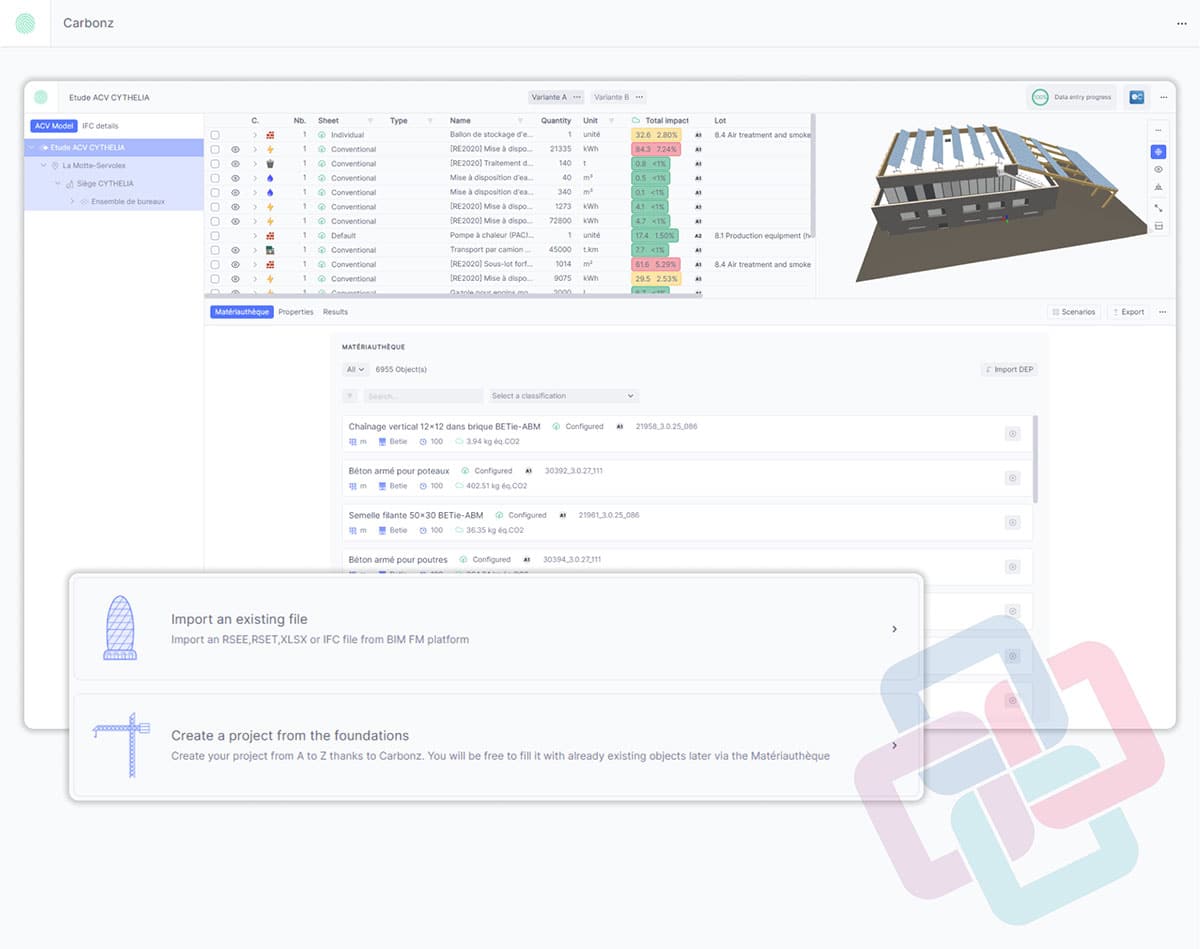
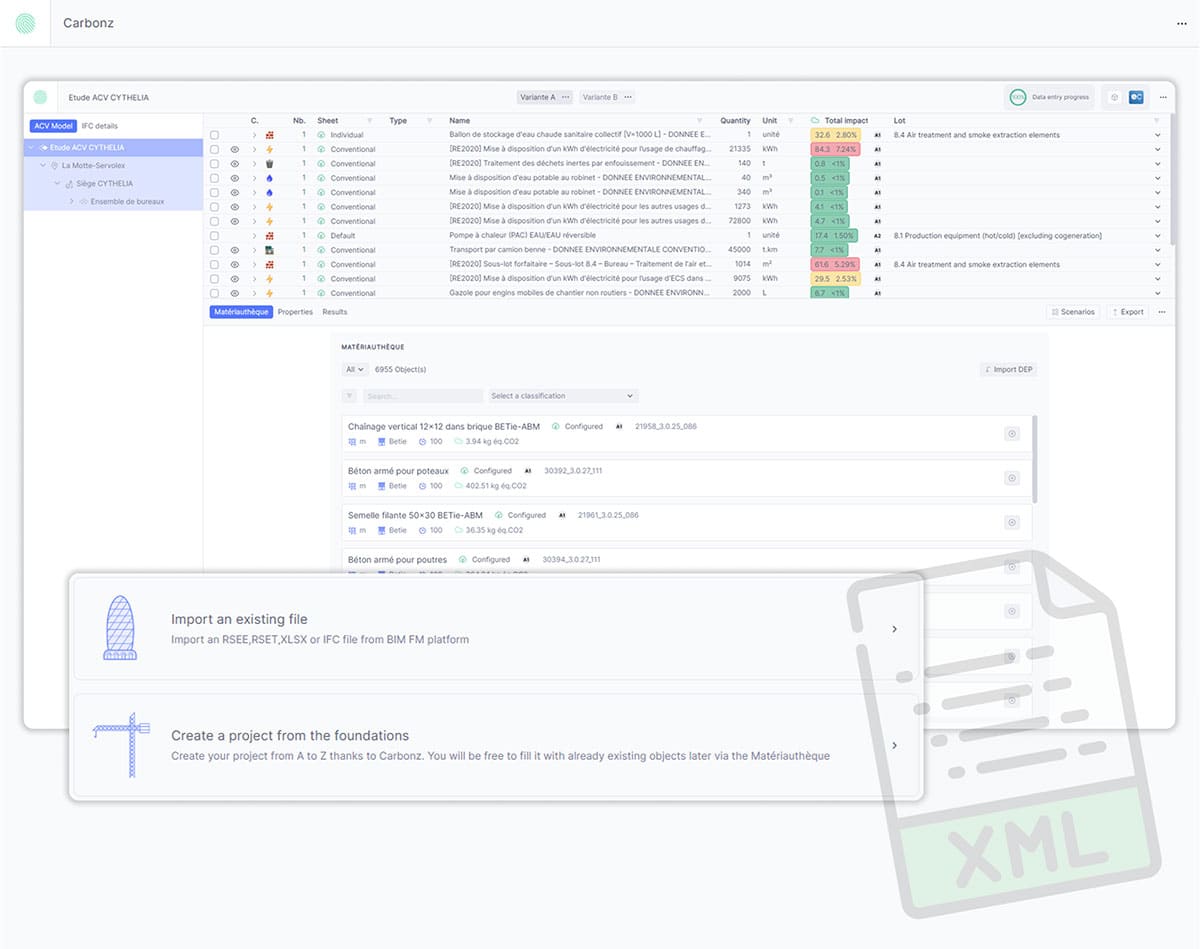
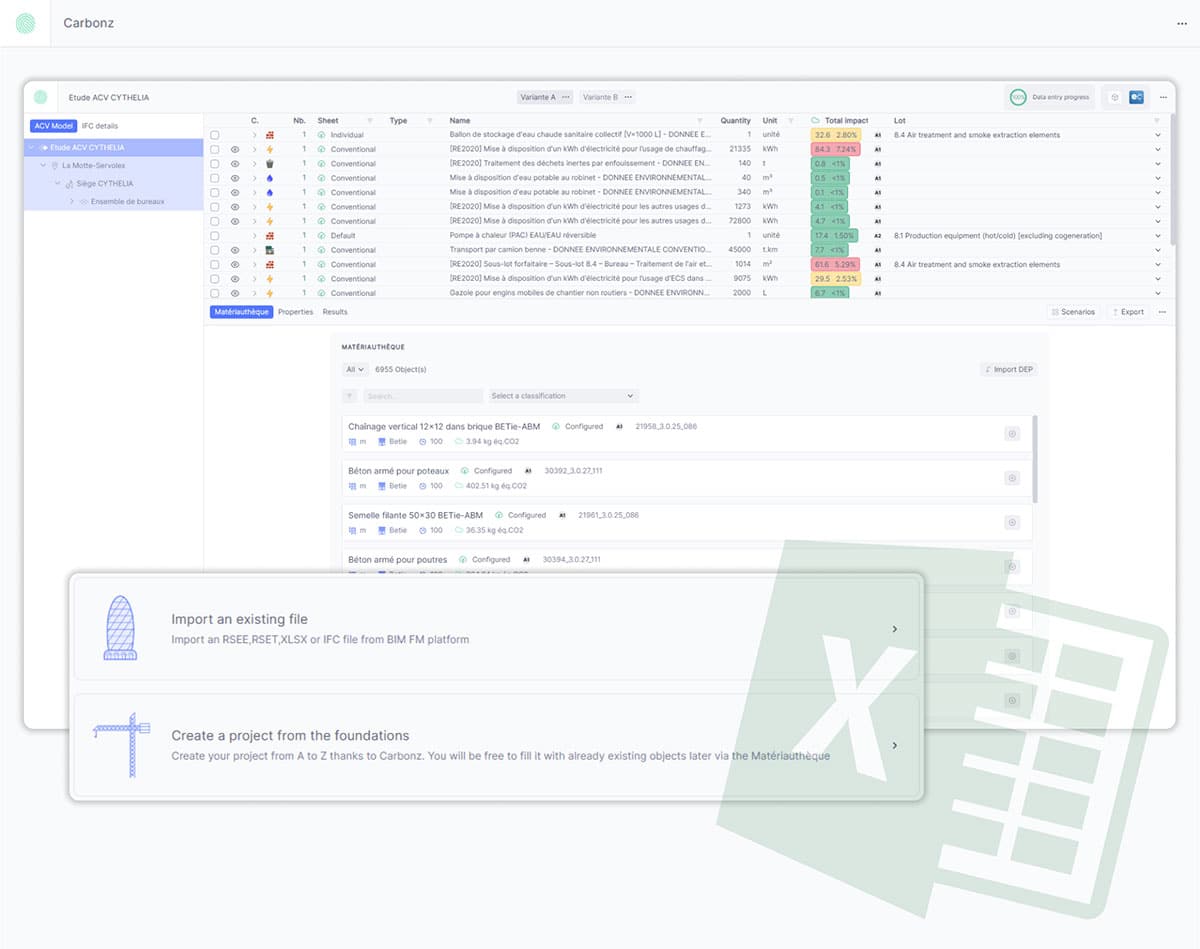
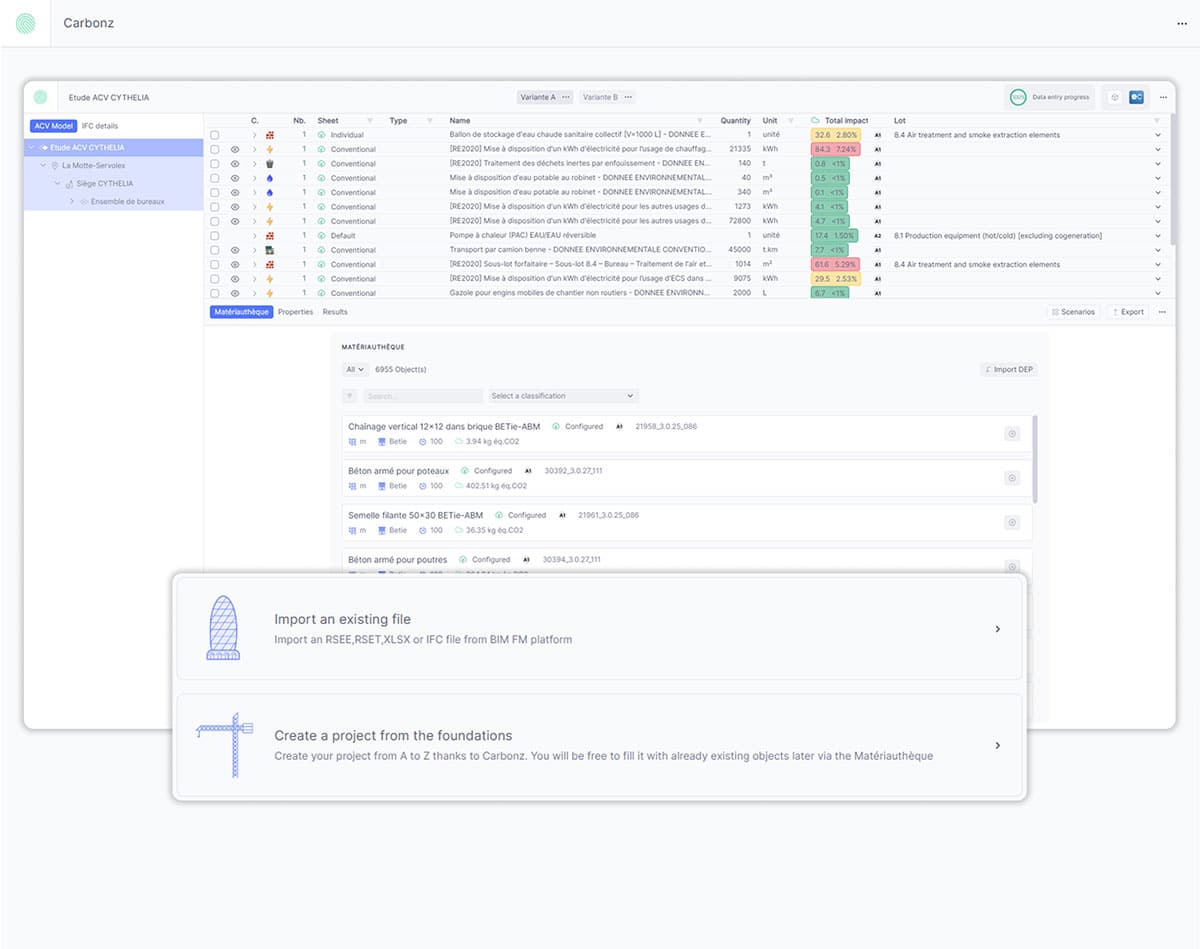
Initial Data for a Carbonz Project:
BIM Model in IFC Format
RSEE and RSET
Quantity Takeoff Files
Manual Project Description
Data Import and Validation Workflows
Carbonz™ accepts structured Excel files organized according to LCA regulatory lots and sublots, requiring quantities and units for environmental data association. The platform’s validation system identifies import anomalies and ensures metric consistency by converting all measurements to the International System of Units (SI).
Example of an Import from a Structured Excel File (XLS):

During project data integration, measurement consistency is ensured, and Carbonz standardizes units according to the International System of Units (SI).
Import of RSET/RSEE Files
These XML files, used in the RE2020 framework, contain hierarchical data that retrieves the properties and environmental data of components based on a thermal study.
Carbonz creates the corresponding LCA model structure and ensures that energy contributors are correctly assigned.
Manual Project Description
If no data file is available, you can create a project manually using the project creation assistant. This involves defining the structure, entering properties, and adding project elements from foundational descriptions:
- Building zones and parcel subdivisions
- Foundation-to-roof component hierarchies
- Material/equipment specifications via guided workflows
The LCA Model Allows Visualization of a RE2020-Formatted Structure, Organized by Key Environmental Contributors:
- Construction Products and Equipment
- Energy Systems
- Water Management
- Construction Site Operations
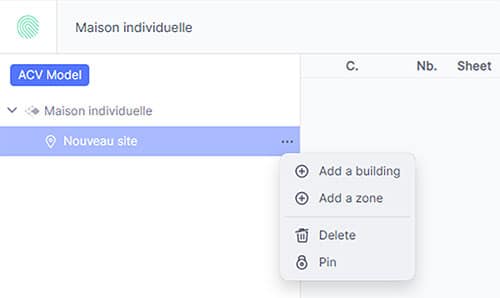
What is the Concept of a "Zone" in the RE2020 LCA Model?
In the RE2020 LCA model, a “zone” refers to specific sub-divisions of the building or project, allowing for detailed environmental impact assessment by sector. These zones help identify and manage environmental contributions based on their function or location.
According to RE2020 methodology, a specific rule is defined, and zone creation follows the model established in the RSET file.
Data Integration via the Digital Model – The BIM Process
BIM Model in IFC Format
Carbonz ideally utilizes the BIM model to integrate carbon considerations from the beginning of the project. This starts with the import and verification of an IFC file.The software harmonizes measurement units according to the International System of Units (SI), ensuring compatibility with functional units and environmental data.
This process associates thermal and environmental data with digital objects within the BIM model, which can then be viewed in Carbonz’s integrated 3D viewer.
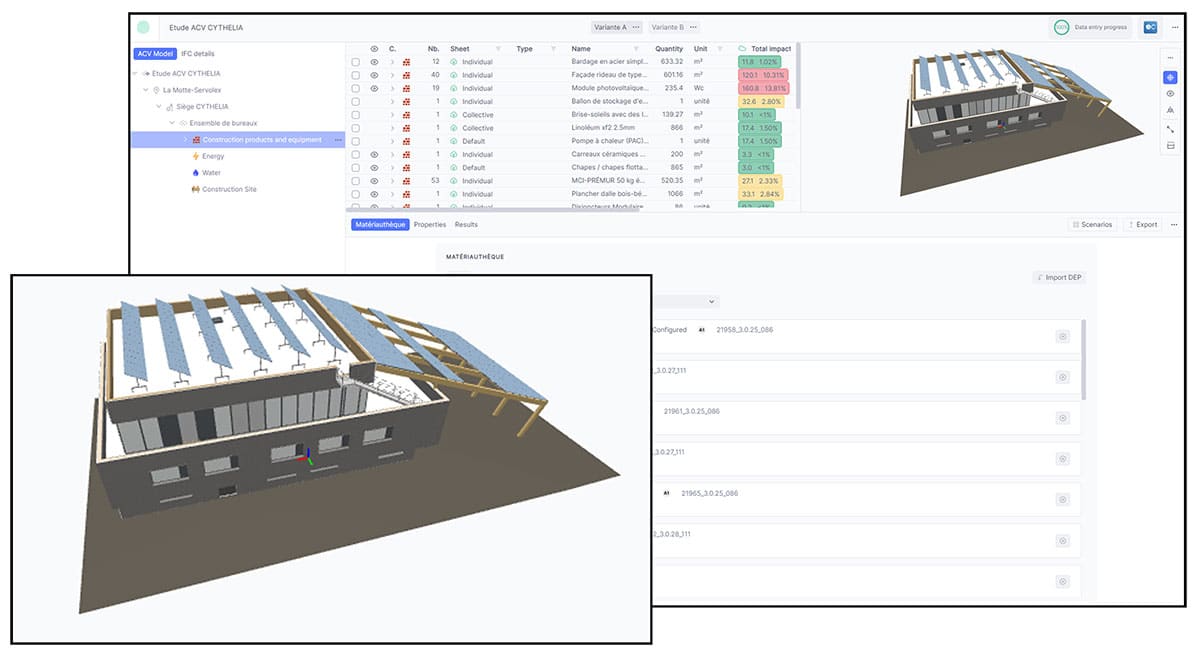
Verification and Extraction of Data from the IFC Model:
When importing an IFC model, Carbonz verifies compliance with the standard and extracts the necessary data for LCA studies.
Model validation is performed using the integrated IFC Checker (IDS technology from the Trace Connect environment). Detected anomalies are reported in BCF format, facilitating collaboration among project stakeholders. Extracted information is categorized according to the LCA model, allowing users to modify classifications and view properties (IFC PSET) through the property interface.
IFC objects are grouped by type to facilitate the LCA workflow.Carbonz Retrieves All Digital Model Data (ie Spaces, Quantities, Lengths, Surfaces). IFC class data is automatically assigned to RE2020 Lots.
Unit Standardization: Converts all measurements to SI units, enabling later functional unit conversions during environmental data mapping.
Functional Unit (FU) in LCA:
A fundamental concept in Life Cycle Assessment (LCA), the functional unit quantifies the service provided by a product or system. It represents the measurable performance of a product system and serves as the reference unit for comparing environmental impacts.
The FU is determined based on the objectives set in the LCA framework and is essential for evaluating different systems or products’ environmental impacts.
3D Model Navigation
Users can navigate through the BIM model or different hierarchical structures while maintaining a permanent visual link between the model elements and the contributor table associated with the project.
3D visualization provides better insight into construction elements and supports decision-making, particularly when associating them with environmental data. If a second screen is available, the BIM model can remain open throughout the LCA study.
Various Manipulation Features Are Available:
- Cross-section creation
- Data filtering
- Data isolation
These features provide significant benefits in conducting LCA studies efficiently.
Displaying Environmental Impacts in the BIM Model:

Carbonz allows direct visualization of product or element impacts within the digital model.
Project Evolution and Digital Model Updates
Carbonz tracks design iterations through:
- Version-Controlled IFC Updates: Automatically links revised models to previous LCA calculations
- Variant Analysis: Compares carbon impacts across design alternatives (see "Variant Process" section)
- BCF-Based Collaboration: Streamlines issue resolution with architects/engineers using BIM Collaboration Format
Carbonz BIM Process Integration:
- Data Round-Tripping: Exports updated LCA results to Revit/ARCHICAD via standardized property sets
- Document Contextualization: Links specifications/certificates to relevant model elements
- Energy Simulation Preview: Upcoming integration with Energy+ engine (end of 2025) for unified thermal-LCA analysis